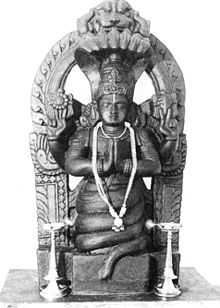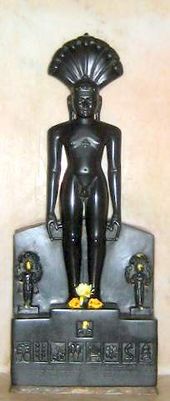Classical era (200 BCE – 500 CE)
This period witnessed many texts of Buddhism, Hinduism and Jainism discussing and systematically compiling yoga methods and practices. Of these, Patanjali's Yoga Sutras are considered as a key work.
Raja yoga
Main article: Rāja yoga
During the period between the Mauryanand the Gupta era (c. 200 BCE–500 CE) philosophical schools of Hinduism,Buddhism and Jainism were taking form and a coherent philosophical system of yoga began to emerge.[70]
Yoga as a philosophy, also called Raja yoga, is mentioned in Sanskrit texts dated to be completed between 200 BCE-100 CE. Kauṭilya's Arthasastra in verse 1.2.10, for example, states that there are three categories of anviksikis(philosophies) – Samkhya (nontheistic), Yoga (theistic) and Lokayata (atheistic materialism).[131][note 20]
Samkhya
Further information: Samkhya
Many traditions in India began to adopt systematic methodology by about first century CE. Of these, Samkhya was probably one of the oldest philosophies to begin taking a systematic form.[133]Patanjali systematized Yoga, building them on the foundational metaphysics of Samkhya. In the early works, the Yoga principles appear together with the Samkhya ideas. Vyasa's commentary on the Yoga Sutras, also called theSamkhyapravacanabhasya (Commentary on the Exposition of the Sankhya Philosophy), describes the relation between the two systems.[134] The two schools have some differences as well. Yoga accepted the conception of "personal god", while Samkhya developed as a rationalist, non-theistic/atheistic system of Hindu philosophy.[43][135][136] Sometimes Patanjali's system is referred to asSeshvara Samkhya in contradistinction to Kapila's Nirivara Samkhya.[137]
The parallels between Yoga and Samkhya were so close that Max Müllersays that "the two philosophies were in popular parlance distinguished from each other as Samkhya with and Samkhya without a Lord...."[138]
Yoga Sutras of Patanjali
Main articles: Raja Yoga andYoga Sutras of Patanjali

Traditional Hindu depiction of Patanjali as an avatar of the divine serpent Shesha.
Quick facts: Yoga Sutras of Patanjali[139] ...
In Hindu philosophy, yoga is the name of one of the six orthodox (which accept the testimony of Vedas) philosophical schools.[140][141] Karel Werner, author ofYoga And Indian Philosophy, believes that the process of systematization of yoga which began in the middle and Yoga Upanishads culminated with the Yoga Sutras of Patanjali.[note 21]
There are numerous parallels in the concepts in ancient Samkhya, Yoga and Abhidharma Buddhist schools of thought, particularly from 2nd century BCE to 1st century AD, notes Larson.[143]Patanjali's Yoga Sutras is a synthesis of these three traditions. From Samkhya, Yoga Sutras adopt the "reflective discernment" (adhyavasaya) of prakrtiand purusa (dualism), its metaphysical rationalism, as well its three epistemicmethods to gaining reliable knowledge.[143] From Abhidharma Buddhism's idea of nirodhasamadhi, suggests Larson, Yoga Sutras adopt the pursuit of altered state of awareness, but unlike Buddhist's concept of no self nor soul, Yoga is physicalist and realist like Samkhya in believing that each individual has a self and soul.[143] The third concept Yoga Sutras synthesize into its philosophy is the ancient ascetictraditions of meditation and introspection, as well as the yoga ideas from middle Upanishads such as Katha, Shvetashvatara and Maitri.[143]
Patanjali's Yoga Sutras are widely regarded as the first compilation of the formal yoga philosophy.[144] The verses of Yoga Sutras are terse. Many later Indian scholars studied them and published their commentaries, such as the Vyasa Bhashya (c. 350–450 CE).[145]Patanjali's yoga is also referred to as Raja yoga.[146] Patanjali defines the word "yoga" in his second sutra:
This terse definition hinges on the meaning of three Sanskrit terms. I. K. Taimni translates it as "Yoga is the inhibition (nirodhaḥ) of the modifications (vṛtti) of the mind (citta)".[147] Swami Vivekananda translates the sutra as "Yoga is restraining the mind-stuff (Citta) from taking various forms (Vrittis)."[148]Edwin Bryant explains that, to Patanjali, "Yoga essentially consists of meditative practices culminating in attaining a state of consciousness free from all modes of active or discursive thought, and of eventually attaining a state where consciousness is unaware of any object external to itself, that is, is only aware of its own nature as consciousness unmixed with any other object."[42][149][150]
Patanjali's writing also became the basis for a system referred to as "Ashtanga Yoga" ("Eight-Limbed Yoga"). This eight-limbed concept is derived from the 29th Sutra of the Book 2 of Yoga Sutras. They are:
- Yama (The five "abstentions"): Ahimsa(Non-violence, non-harming other living beings),[151] Satya (truthfulness, non-falsehood),[152] Asteya (non-stealing),[153] Brahmacharya (celibacy, fidelity to one's partner),[153] andAparigraha (non-avarice, non-possessiveness).[152]
- Niyama (The five "observances"):Śauca (purity, clearness of mind, speech and body),[154] Santosha (contentment, acceptance of others and of one's circumstances),[155] Tapas (persistent meditation, perseverance, austerity),[156]Svādhyāya (study of self, self-reflection, study of Vedas),[157] and Ishvara-Pranidhana (contemplation of God/Supreme Being/True Self).[155]
- Asana: Literally means "seat", and in Patanjali's Sutras refers to the seated position used for meditation.
- Pranayama ("Suspending Breath"):Prāna, breath, "āyāma", to restrain or stop. Also interpreted as control of the life force.
- Pratyahara ("Abstraction"): Withdrawal of the sense organs from external objects.
- Dharana ("Concentration"): Fixing the attention on a single object.
- Dhyana ("Meditation"): Intense contemplation of the nature of the object of meditation.
- Samadhi ("Liberation"): merging consciousness with the object of meditation.
Yoga school as developed in Patanjali's Yoga Sutras and Vedanta schools are two largest surviving schools of Hindu traditions. They share many thematic principles, concepts and belief in self/soul, but diverge in degree, style and some of their methods. Epistemologically, Yoga school accepts three means to reliable knowledge, while Advaita Vedanta accepts six ways.[158]Yoga disputes the monism of Advaita Vedanta.[159] Yoga school believes that in the state of moksha, each individual discovers the blissful, liberating sense of himself or herself as an independent identity; Advaita Vedanta, in contrast, believes that in the state of moksha, each individual discovers the blissful, liberating sense of himself or herself as part of Oneness with everything, everyone and the Universal Self. They both hold that the free conscience is aloof yet transcendent, liberated and self-aware. Further, Advaita Vedanta school enjoins the use of Patanjali's yoga practices and the reading of Upanishads for those seeking the supreme good, ultimate freedom andjivanmukti.[159]
Yoga Yajnavalkya
Main article: Yoga Yajnavalkya
संयोगो योग इत्युक्तो जीवात्मपरमात्मनोः॥
saṁyogo yoga ityukto jīvātma-paramātmanoḥ॥
Union of the self (jivātma) with the Divine (paramātma) is said to be yoga.
saṁyogo yoga ityukto jīvātma-paramātmanoḥ॥
Union of the self (jivātma) with the Divine (paramātma) is said to be yoga.
The Yoga Yajnavalkya is a classical treatise on yoga attributed to the Vedic sage Yajnavalkya. It takes the form of a dialogue between Yajnavalkya and his wife Gargi, a renowned female philosopher.[161] The text contains 12 chapters and its origin has been traced to the period between the second century BCE and fourth century CE.[162]Many yoga texts like the Hatha Yoga Pradipika, the Yoga Kundalini and theYoga Tattva Upanishads have borrowed verses from or make frequent references to the Yoga Yajnavalkya.[163] In the Yoga Yajnavalkya, yoga is defined asjivatmaparamatmasamyogah, or the union between the individual self (jivatma) and the Divine (paramatma).[160]
Jainism
Main article: Jainism

Tirthankara Parsva in Yogic meditation in theKayotsarga posture.
According to Tattvarthasutra, 2nd century CE Jain text, yoga is the sum of all the activities of mind, speech and body.[7]Umasvati calls yoga the cause of "asrava" or karmic influx[164] as well as one of the essentials—samyak caritra—in the path to liberation.[164] In hisNiyamasara, Acarya Kundakunda, describes yoga bhakti—devotion to the path to liberation—as the highest form of devotion.[165] Acarya Haribhadra and Acarya Hemacandra mention the five major vows of ascetics and 12 minor vows of laity under yoga. This has led certain Indologists like Prof. Robert J. Zydenbos to call Jainism, essentially, a system of yogic thinking that grew into a full-fledged religion.[166] The five yamasor the constraints of the Yoga Sutras of Patanjali bear a resemblance to the five major vows of Jainism, indicating a history of strong cross-fertilization between these traditions.[167][note 22]
Mainstream Hinduism's influence on Jain yoga is noticed as Haribhadrafounded his eightfold yoga and aligned it with Patanjali's eightfold yoga.[169]
Yogacara school
Main article: Yogacara
In the late phase of Indian antiquity, on the eve of the development of Classical Hinduism, the Yogacara movement arises during the Gupta period (4th to 5th centuries). Yogacara received the name as it provided a "yoga," a framework for engaging in the practices that lead to the path of thebodhisattva.[170] The yogacara sect teaches "yoga" as a way to reach enlightenment.[171]



No comments:
Post a Comment